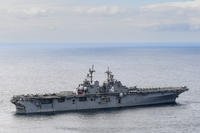The international financial crisis, compounded by the poor quality of strategic decision making over years, will force the United States to scale back its global commitments and revise its global strategy.
"We are really out of money and we just can't do this any more," said Loren Thompson, defense analyst and COO of the Lexington Institute. "The world has to get used to taking care of itself."
One might call this the transformation of America from the "indispensable nation," in former Secretary of State Madeleine Albright's memorable phrase, to the insolvent nation.
"With the exception of special operations forces, all of our military forces are in crisis today," Gregory Martin, a defense consultant and retired Air Force general, said. Martin, pointing to the mix of airplanes needed to sustain America's national goals and warfighting needs, made it clear that the country has solemn and painful choices to make as it mulls the fate of the F-22, F-35 and other combat aircraft. "If you can't afford that [mix], then your national objectives have to be scaled back," told the audience.
In a clear indication of just how battered and uncertain the Air Force is, Rebecca Grant, director of the Mitchell Institute and author of its new study "Combat Air Forces in Crisis," said "we don't really know where we are going."
Grant, Thompson and Martin were among four analysts speaking at a seminar on air power put on by the Mitchell Institute for Air Power Studies.
Barry Watts, an analyst at the Center for Strategic and Budgetary Assessment and former head of PA and E, said part of the reason the US faces these grim choices -- beyond the onerous financial situation -- is that the nation has lost the capacity to make clear and effective strategic choices.
As proof of the poor quality of strategic policy making, Watts pointed to the recent policy suggestion from the Office of Management and Budget that the Pentagon push the tanker buy out five years and scrap the next generation bomber. To get out of this fix, "the US needs to make clear strategic choices and do them well," he said.
But the paucity of clear thinking has left us, Grant noted, with a combat air force comprised of 80 percent legacy airplanes by 2014, an unparalleled force of aging planes. The force will slowly recover to 62 percent legacy planes by 2020. But none of the analysts were terribly upbeat about the future of the F-35, which would provide the bulk of the new planes. Grant said the country must stick to plans to build 80 aircraft a year in order to keep costs low and ensure we replace those old planes.
How bad are things for the Air Force? Thompson, in a soliloquy of program cuts, put the service's future this way: "The bottom line is this for the Air Force. There isn't going to be a Transformational Communications Satellite, a Joint Tactical Radio and a next generation bomber; and there will be no production of the F-22 beyond 2011."








